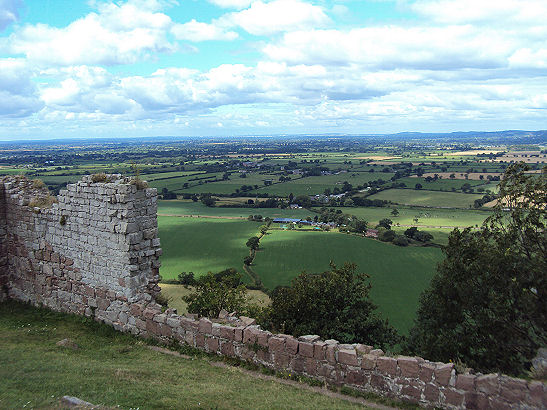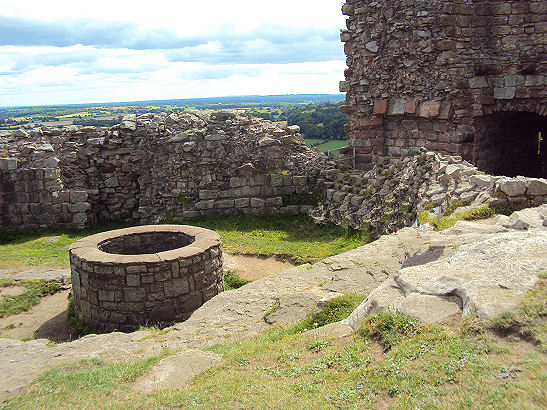Beeston Castle
Grid Ref: SJ 537 592
Standing majestically on a sheer rocky crag of red sandstone, 350 feet above the Cheshire Plain, Beeston Castle dominates the surrounding landscape.

The castle dates from 1225, although the site was first used as a fortress as far back as the Bronze Age, it became an important Bronze Age metal-working site, and later an immense Iron Age hillfort, of which traces remain. In addition to Iron Age remains, archaeologists have discovered Neolithic flint arrow heads on the crag, as well as the remains of a Bronze Age community and Bronze Age axe heads and a knife. Seven circular buildings were identified as being either late Bronze Age or early Iron Age in origin.
The view from the Inner Bailey

The present castle was founded by Ranulf, the sixth Earl of Chester (1170-1232), who following his return from the Fifth Crusade was granted the lands around Beeston. In medieval documents the castle is referred to as 'Castellum de Rupe', the Castle on the Rock.The outer bailey was roughly rectangular in shape, with 6 feet (2 metre) thick walls. The walls, sections of which still remain today, contain a number of D-shaped towers, an innovation in English castles at that time. The inner bailey was situated on the rocky summit at the western end of the crag.
To provide a supply of fresh water two wells were dug into the rock, one of them, measuring 370 feet (113 metres) deep, is one of the deepest castle wells in England. Legend relates that King Richard II, en-route to Chester where he boarded a ship to Ireland to quell a rebellion, concealed his treasure in the well in 1399. On his return to England Richard was deposed by his cousin, Henry, Duke of Lancaster, who became King Henry IV. Many attempts to explore the well have discovered no treasure, although the most recent, which took place in 1976, did reveal mysterious openings leading from the well shaft.
Beeston's Well- one of the deepest castle wells in England

Two sets of perimiter defensive walls surround the castle, and the inner wall has a very impressive gateway. A wide ditch surrounds the entire site. There are open backed towers, a square garderobe tower and the remains of a huge gatehouse. The walls command superb panoramic views which stretch over eight counties, over the Cheshire Plain and the Peak District, from the Pennines in the east to the Welsh mountains in the west.
Beeston Castle was seized by King Henry III in 1237, and was used by both himself and later his son, King Edward I, as a base for their campaigns against the Welsh. Henry made additions to the castle and used it as a prison for Welsh captives. The castle was kept in a good state of repair for the duration of the Welsh wars but by the middle of the fourteenth century the kings of England had no further need for the fortification so it was sold off to Sir Hugh Beeston, a local knight.

During the period of the Civil War Beeston was to become a royalist stronghold and it witheld a Parliamentary siege for a period of twelve months. Beeston was seized by Parliamentary forces commanded by Sir William Brereton on 20th February 1643. On 13th December 1643 Captain Thomas Sandford mounted a daring Royalist counter attack, along with only eight soldiers he crept into Beeston at night and surprised the castle governor, Captain Thomas Steele, who surrendered on the condition that he would be allowed to march out of the castle with honours. Steele was later tried and executed for his failure to hold the castle. The Royalists survived a siege by parliamentary forces from November 1644 until November 1645, when their lack of food forced them to surrender. The defences of the castle were finally destroyed at the end of the War, by order of Parliament.
The 4000 year-old story of the castle is displayed in a special exhibition 'The Castle on the Rock'. The museum, which is housed in a modern extension of the nineteenth century gatehouse, retells the castle's story through a display of models based on archaeological surveys and also a selection of artefacts including flint arrow heads dating from the Neolithic period; bronze age axe heads; funeral urns; loom weights and lead shot dating from the end of the castle's active life. Beeston Castle is located north of Beeston, off Tattenhall Lane and is now in the care of English Heritage.
